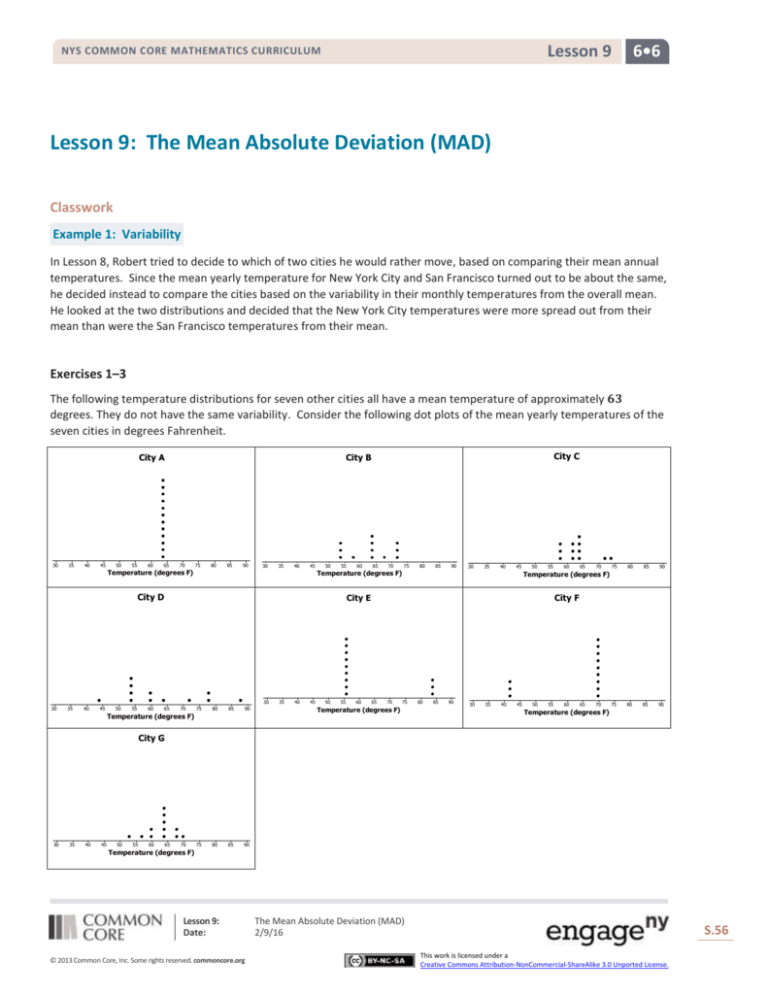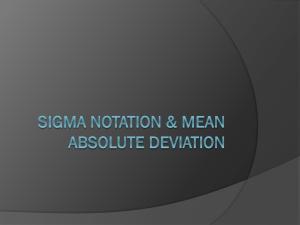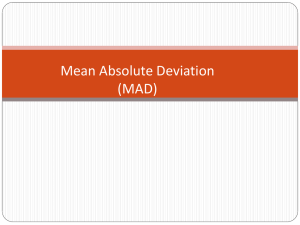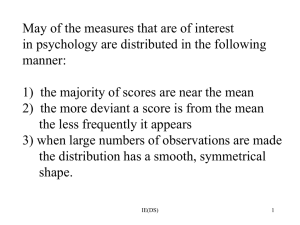
6•6
Lesson 9
NYS COMMON CORE MATHEMATICS CURRICULUM
Lesson 9: The Mean Absolute Deviation (MAD)
Classwork
Example 1: Variability
In Lesson 8, Robert tried to decide to which of two cities he would rather move, based on comparing their mean annual
temperatures. Since the mean yearly temperature for New York City and San Francisco turned out to be about the same,
he decided instead to compare the cities based on the variability in their monthly temperatures from the overall mean.
He looked at the two distributions and decided that the New York City temperatures were more spread out from their
mean than were the San Francisco temperatures from their mean.
Exercises 1–3
The following temperature distributions for seven other cities all have a mean temperature of approximately 𝟔𝟑
degrees. They do not have the same variability. Consider the following dot plots of the mean yearly temperatures of the
seven cities in degrees Fahrenheit.
City A
30
35
40
45
50
55
60
65
70
75
80
85
90
Temperature (degrees F)
30
35
40
45
50
55
40
45
50
55
60
65
70
75
80
85
90
30
35
40
45
50
55
65
70
75
80
85
90
75
80
85
90
Temperature (degrees F)
35
40
45
50
55
60
60
65
70
75
80
85
90
75
80
85
90
Temperature (degrees F)
City F
City E
30
35
60
Temperature (degrees F)
City D
30
City C
City B
65
70
75
Temperature (degrees F)
80
85
90
30
35
40
45
50
55
60
65
70
Temperature (degrees F)
City G
30
35
40
45
50
55
60
65
70
Temperature (degrees F)
Lesson 9:
Date:
© 2013 Common Core, Inc. Some rights reserved. commoncore.org
The Mean Absolute Deviation (MAD)
2/9/16
S.56
This work is licensed under a
Creative Commons Attribution-NonCommercial-ShareAlike 3.0 Unported License.
56
Lesson 9
NYS COMMON CORE MATHEMATICS CURRICULUM
6•6
1.
Which distribution has the smallest variability of the temperatures from its mean of 𝟔𝟑 degrees? Explain your
answer.
2.
Which distribution(s) seems to have the most variability of the temperatures from the mean of 𝟔𝟑 degrees? Explain
your answer.
3.
Order the seven distributions from least variability to most variability. Explain why you listed the distributions in the
order that you chose.
Example 2: Measuring Variability
Based on just looking at the distributions, there are different orderings of variability that seem to make some sense.
Sabina is interested in developing a formula that will give a number that measures the variability in a data distribution.
She would then use the formula for each data set and order the distributions from lowest to highest. She remembers
from a previous lesson that a deviation is found by subtracting the mean from a data point. The formula was
summarized as: deviation = data point – mean. Using deviations to develop a formula measuring variability is a good
idea to consider.
Exercises 4–6
The dot plot for the temperatures in City 𝐺 is shown below. Use the dot plot and the mean temperature of 63 degrees
to answer the following questions.
City G
30
35
40
45
50
55
60
65
70
75
80
85
90
Temperature (degrees F)
Lesson 9:
Date:
© 2013 Common Core, Inc. Some rights reserved. commoncore.org
The Mean Absolute Deviation (MAD)
2/9/16
S.57
This work is licensed under a
Creative Commons Attribution-NonCommercial-ShareAlike 3.0 Unported License.
57
Lesson 9
NYS COMMON CORE MATHEMATICS CURRICULUM
4.
6•6
Fill in the following table for City 𝐺 temperature deviations.
Temp
Deviation
Result
53
53 − 63
−10
57
57 − 63
−6
60
60 − 63
−3
60
60 − 63
−3
64
64 − 63
+1
64
64 − 63
+1
64
64
64
68
68
70
Sum
5.
Why should the sum of your deviations column be equal to zero? (Hint: Recall the balance interpretation of the
mean of a data set.)
6.
Another way to graph the deviations is to write them on a number line as follows. What is the sum of the positive
deviations (the deviations to the right of the mean)? What is the sum of the negative deviations (the deviations to
the left of the mean)? What is the total sum of the deviations?
Lesson 9:
Date:
© 2013 Common Core, Inc. Some rights reserved. commoncore.org
The Mean Absolute Deviation (MAD)
2/9/16
S.58
This work is licensed under a
Creative Commons Attribution-NonCommercial-ShareAlike 3.0 Unported License.
58
Lesson 9
NYS COMMON CORE MATHEMATICS CURRICULUM
6•6
Example 3: Finding the Mean Absolute Deviation (MAD)
By the balance interpretation of the mean, the sum of the deviations for any data set will always be zero. Sabina is
disappointed that her idea of developing a measure of variability using deviations isn’t working. She still likes the
concept of using deviations to measure variability, but the problem is that the sum of the positive deviations is cancelling
out the sum of the negative deviations. What would you suggest she do to keep the deviations as the basis for a formula
but to avoid the deviations cancelling out each other?
Exercises 7–8
7.
One suggestion to possibly help Sabina is to take the absolute value of the deviations.
a.
Fill in the following table.
Temp
Deviation
Result
Abs
53
53 − 63
−10
+10
57
57 − 63
−6
+6
60
60 − 63
−3
+3
60
60 − 63
−3
+3
64
64 − 63
+1
+1
64
64 − 63
+1
+1
64
64
64
68
68
70
b.
From the following graph, what is the sum of the absolute deviations?
Lesson 9:
Date:
© 2013 Common Core, Inc. Some rights reserved. commoncore.org
The Mean Absolute Deviation (MAD)
2/9/16
S.59
This work is licensed under a
Creative Commons Attribution-NonCommercial-ShareAlike 3.0 Unported License.
59
NYS COMMON CORE MATHEMATICS CURRICULUM
Lesson 9
6•6
c.
Sabina suggests that the mean of the absolute deviations could be a measure of the variability in a data set. Its
value is the average distance that all the data values are from the mean temperature. It is called the Mean
Absolute Deviation and is denoted by the letters, MAD. Find the MAD for this data set of City 𝐺 temperatures.
Round to the nearest tenth.
d.
Find the MAD for each of the temperature distributions in all seven cities, and use the values to order the
distributions from least variability to most variability. Recall that the mean for each data set is 63 degrees.
Does the list that you made in Exercise 2 by just looking at the distributions match this list made by ordering
MAD values?
e.
Which of the following is a correct interpretation of the MAD?
i.
The monthly temperatures in City 𝐺 are spread 3.7 degrees from the approximate mean of 63 degrees.
ii.
The monthly temperatures in City 𝐺 are, on average, 3.7 degrees from the approximate mean
temperature of 63 degrees.
iii.
The monthly temperatures in City 𝐺 differ from the approximate mean temperature of 63 degrees by 3.7
degrees.
Lesson 9:
Date:
© 2013 Common Core, Inc. Some rights reserved. commoncore.org
The Mean Absolute Deviation (MAD)
2/9/16
S.60
This work is licensed under a
Creative Commons Attribution-NonCommercial-ShareAlike 3.0 Unported License.
60
Lesson 9
NYS COMMON CORE MATHEMATICS CURRICULUM
8.
6•6
The dot plot for City A temperatures follows.
City A
30
35
40
45
50
55
60
65
70
75
80
85
90
Temperature (degrees F)
a.
How much variability is there in City A’s temperatures? Why?
b.
Does the MAD agree with your answer in part (a)?
Lesson 9:
Date:
© 2013 Common Core, Inc. Some rights reserved. commoncore.org
The Mean Absolute Deviation (MAD)
2/9/16
S.61
This work is licensed under a
Creative Commons Attribution-NonCommercial-ShareAlike 3.0 Unported License.
61
Lesson 9
NYS COMMON CORE MATHEMATICS CURRICULUM
6•6
Lesson Summary
In this lesson, a formula was developed that measures the amount of variability in a data distribution.
The absolute deviation of a data point is how far away that data point is from the mean.
The Mean Absolute Deviation (MAD) is computed by finding the mean of the absolute deviations in the
distribution.
The value of MAD is the average distance that all the data values are from the mean.
A small MAD indicates that the distribution has very little variability.
A large MAD indicates that the data points are spread far away from the mean.
Problem Set
1.
Suppose the dot plot on the left shows the number of goals a boys’ soccer team has scored in six games so far this
season, and the dot plot on the right shows the number of goals a girls’ soccer team has scored in six games so far
this season. The mean for both of these teams is 3.
a.
Before doing any calculations, which dot plot has the larger MAD? Explain how you know.
Lesson 9:
Date:
© 2013 Common Core, Inc. Some rights reserved. commoncore.org
The Mean Absolute Deviation (MAD)
2/9/16
S.62
This work is licensed under a
Creative Commons Attribution-NonCommercial-ShareAlike 3.0 Unported License.
62
Lesson 9
NYS COMMON CORE MATHEMATICS CURRICULUM
b.
Use the following tables to find the MAD number of goals for each distribution. Round your calculations to the
nearest hundredth.
Boys’ Team
c.
2.
6•6
#Goals
Deviations
0
0
3
3
5
7
Sum
−3
−3
3−3=0
Girls’ Team
Absolute
Deviations
#Goals
Deviations
Absolute
Deviations
2
2
3
3
3
5
Sum
Based on the computed MAD values, for which distribution is the mean a better indication of a typical value?
Explain your answer.
Recall Robert’s problem of deciding whether to move to New York City or to San Francisco. The table of
temperatures (in degrees Fahrenheit) and deviations for the New York City distribution is as follows:
NYC
Temp
Deviation
Jan
39
−24
Feb
42
−21
Mar
50
−13
Apr
61
−2
May
71
8
Jun
81
18
Jul
85
22
Aug
84
21
Sep
76
13
Oct
65
2
Nov
55
−8
Dec
47
−16
a.
The dot plot below is written with the deviations above each of the monthly temperatures. What is the sum of
all of the deviations? Are you surprised? Explain.
b.
The absolute deviations for the monthly temperatures are shown below. Use this information to calculate the
MAD. Explain the MAD in words for this problem.
c.
Complete the following table and then use the values to calculate the MAD for the San Francisco data
distribution.
Month
Temp
Deviations
Absolute Deviations
d.
Jan
57
Feb
60
Mar
62
Apr
63
−1
May
64
0
Jun
67
+3
Jul
67
Aug
68
Sep
70
Oct
69
Nov
63
Dec
58
Comparing the MAD values for New York City and San Francisco, which city would Robert choose to move to if
he is interested in having a lot of variability in monthly temperatures? Explain using the MAD.
Lesson 9:
Date:
© 2013 Common Core, Inc. Some rights reserved. commoncore.org
The Mean Absolute Deviation (MAD)
2/9/16
S.63
This work is licensed under a
Creative Commons Attribution-NonCommercial-ShareAlike 3.0 Unported License.
63
Lesson 9
NYS COMMON CORE MATHEMATICS CURRICULUM
3.
6•6
Consider the following data of the number of green jellybeans in seven bags sampled from five different candy
manufacturers (Awesome, Delight, Finest, Sweeties, YumYum). Note that the mean in each distribution is 42 green
jellybeans.
Awesome
Delight
Finest
Sweeties
YumYum
a.
Bag 2
40
31
36
39
36
Bag 3
41
36
40
42
42
Bag 4
42
42
43
42
42
Bag 5
42
48
47
42
45
Bag 6
43
53
50
44
48
Bag 7
46
62
52
49
48
Complete the following table of the deviations of the number of green jellybeans from the mean number of
green jellybeans in the seven bags.
Awesome
Delight
Finest
Sweeties
YumYum
b.
Bag 1
40
22
26
36
33
Bag 1
−2
−20
−16
Bag 2
−2
−11
Bag 3
−1
−6
Bag 4
0
Bag 5
0
Bag 6
+1
Bag 7
+4
Based on what you learned about MAD, which manufacturer do you think will have the lowest MAD? Calculate
the MAD for the manufacturer you selected.
Lesson 9:
Date:
© 2013 Common Core, Inc. Some rights reserved. commoncore.org
The Mean Absolute Deviation (MAD)
2/9/16
S.64
This work is licensed under a
Creative Commons Attribution-NonCommercial-ShareAlike 3.0 Unported License.
64









